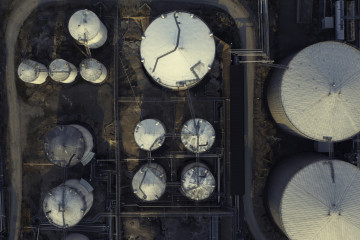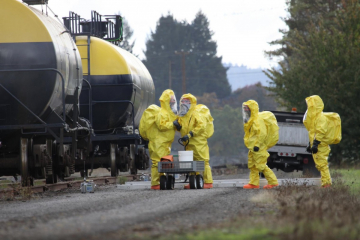Preparing for the unknown as a business can be daunting. With emergencies, you never know what could happen that could lead to downtime, lost profit, injury, or even data loss. Everything from natural disasters, which are becoming more common due to our warming planet, oil spills, security breaches, stormwater pollution, and even on-the-job injuries fall under the category of emergencies you need to plan for. Creating a comprehensive business continuity plan is vital to staying open after an emergency.
But, it’s something many businesses fail to follow through with, which can lead to serious consequences, including business closure. In fact, according to FEMA, 25% of companies don’t reopen after an emergency. So, how do you know what plans to have in place for your specific type of facility? Below, we’ll break down what plans are available to you, what they do, and which ones you should use in your facility – focusing on low-risk and high-risk facilities.
Low-Risk Facilities
Emergency Action Plans
Most companies understand that no matter what type of operation they have, they will need some kind of plan or process for managing emergency situations. This is especially true for emergencies that may require medical treatment, evacuation, or shelter-in-place. Companies then typically develop an emergency action plan which should include:
- How to report an emergency
- Evacuation types and routes
- How to account for all employees post-evacuation
- Responsibilities for employees, particularly if there is a team trained to provide first aid
Employers can add information such as how drills will be conducted, how to assist employees with evacuating if they need additional assistance, and the process for assisting employees with first aid if trained. These emergency action plans need to be reviewed with each employee, so they understand what action to take in these types of situations.
Often emergency action plans and emergency response plans are used interchangeably, but they are two different things. The Occupational Safety and Health Administration (OSHA) explains the purpose of emergency action plans is to “facilitate and organize employer and employee actions during workplace emergencies.” The term emergency response plan is used in 29 CFR 1910.120 Hazardous Materials regarding hazardous waste operations. It has some of the same components as the emergency action plan but contains more details about hazards associated with these operations.
Injury Illness Prevention Plans and Other State Plans
Other documentation or plans include those required by OSHA State Plans. This includes California’s Injury Illness and Prevention Plans and Washington State’s Accident Prevention Program. These are typically required regardless of other written documentation you already have in place. Not having this document and not implementing it with employees may result in fines.
Plans for High-Risk Facilities
In addition to the above, consider these:
Spill Prevention Plans
To prevent the accidental release of oil to the environment, 40 CFR 112 may require the development of a spill prevention, control, and countermeasure (SPCC) plan, depending on your aboveground oil storage capacity. Storage containers may include tanks, containers, and oil-filled equipment if they have the capacity to hold 55 gallons or more. Because “oil” can mean petroleum, animal fats, vegetable oils, used oil, and oil mixtures (like oily water), even agricultural facilities can be required to develop an SPCC plan for the storage of vegetable and animal oils.
The SPCC plan is a living document the facility owner/operator must implement that identifies oil storage inventory, control and countermeasures for oil spills, and notification and response procedures for potential spills.
The SPCC rule referenced above applies to facilities that:
- Have an aboveground oil storage capacity of more than 1,320 U.S. gallons (in containers that are 55 gallons or greater), or a completely buried oil storage capacity of more than 42,000 U.S. gallons;
- Could reasonably expect to discharge oil to navigable waters or adjoining shorelines in quantities that may be harmful; and
- Are non-transportation related.
SPCC plans are required to comply with the Federal 40 CFR 112 rule under the Clean Water Act. Many states may also have requirements to implement plans like SPCC for the prevention and mitigation of oil spills.
Stormwater Pollution Prevention Plans
A Stormwater Pollution Prevention Plan (SWPPP) is a site-specific document that captures all activities and conditions at an industrial site that could result in pollution of navigable waters. An SWPPP also includes steps that the facility will follow towards monitoring stormwater discharge points and preventing unpermitted pollution.
An SWPPP should be a key component of a facility’s response planning and acts as a guide to linking the facility's obligations under their stormwater permit to the activities and conditions at the facility. An SWPPP is also an organizational document, identifying key personnel that make up the pollution prevention team who support emergency management and response.
For reference, per the EPA, an industrial SWPPP should (at a minimum) contain the following sections:
- Facility description and contact information (including the pollution prevention team names and responsibilities)
- Potential pollutant sources (i.e. what activities and conditions could cause pollution)
- Stormwater control measures (i.e. how the facility is working to prevent potential pollutant sources from becoming stormwater pollutants)
- Schedule and procedures related to stormwater monitoring and inspections
- Supporting documentation
- Corrective Actions
- Certification
For industrial users, the EPA and the states with delegated authority publish a list of NAICS/SIC codes for industries where permit registration and an SWPPP are required. It is best to contact Antea Group or check with your state agency to determine if your industry is covered. A great quick self-check is to consider if your operations store materials or conduct work outside that will interact with precipitation and stormwater runoff. This includes raw materials, products, cuttings, dumpsters, dust and residue from ventilation/exhaust stacks, fluids, above ground storage tanks, machinery and equipment, and spills or residue from past activities.
So, why is this type of plan so important? Various forms of precipitation, such as rainfall and snow, that find themselves flowing (snow as snowmelt) over land or impervious surfaces, are considered stormwater runoff. As this runoff travels it interacts with its environment collecting dirt, debris, sediment, oils, chemicals, and trash, acting as a large contaminant conveyor belt that could potentially result in harm to navigable waters. Stormwater is one of the primary causes of pollution in our waters today, especially when interacting with poorly managed industrial facilities and operations.
Recognizing the potential for harm to navigable waters, Congress and the U.S. EPA passed the Clean Water Act (CWA) which created the National Pollutant Discharge Elimination System (NPDES) in 1972, which established requirements for managing stormwater runoff and led to the Water Quality Act of 1987. Together, these regulations define requirements for stormwater discharge permitting and planning to minimize pollution to navigable waters with the goal of keeping our waters safe for wildlife, recreation, and consumption.
Facility Response Plans (FRPs)
As a specific subset to spill response plans, facilities that could reasonably be expected to cause "substantial harm" to the environment by discharging oil into navigable waters are required to prepare and submit Facility Response Plans (FRPs). FRPs must go into more detail regarding the specific spill hazards and receptors that could be potentially affected by a major oil spill, equipment, and resources that will be utilized to mitigate and clean up the spill, identification of a qualified individual having full authority to implement response actions, and describe training, testing, and drills for spill response actions.
Again, the FRP is a living document intended to guide the facility owner/operator in the necessary actions specific to the facility and nearby potentially affected receptors for proper planning, notification, spill response, and cleanup of a significant oil spill.
A facility may pose "substantial harm" according to the FRP rule if it: has a total oil storage capacity greater than or equal to 42,000 gallons and it transfers oil over water to/from vessels; or has a total oil storage capacity greater than or equal to 1 million gallons and meets one of the following conditions:
- Does not have sufficient secondary containment for each aboveground storage area.
- Is located at a distance such that a discharge from the facility could cause "injury" to fish, wildlife, and sensitive environments.
- Is located at a distance such that a discharge from the facility would shut down a public drinking water intake.
- Within the past five years, has had a reportable discharge greater than or equal to 10,000 gallons.
If you have one of these facilities, you need an FRP to comply with the Federal 40 CFR 112 rule under the Clean Water Act.
It’s Time to Start Planning
Now is always the time to start planning for future emergencies and disasters. As a business, it’s one of the best things you can do to protect your workers, buildings, and profits. If you need help, reach out to Antea Group for our EHS Auditing and Compliance Practice or our Spill and Response Plan service line for more information on how to plan ahead.
Want more news and insights like this?
Sign up for our monthly e-newsletter, The New Leaf. Our goal is to keep you updated, educated, and even a bit entertained as it relates to all things EHS and sustainability.
Have any questions?
Contact us to discuss your environment, health, safety, and sustainability needs today.








